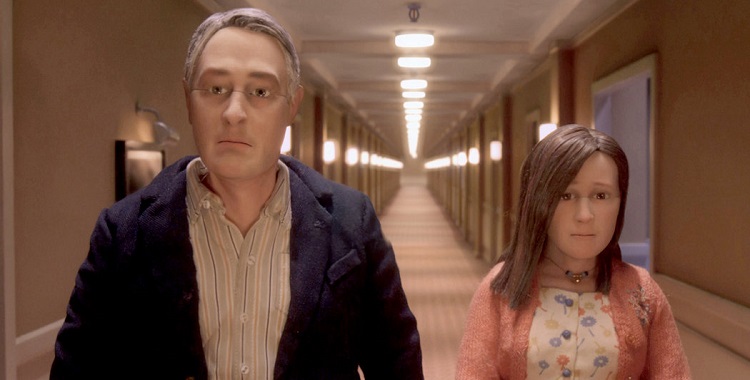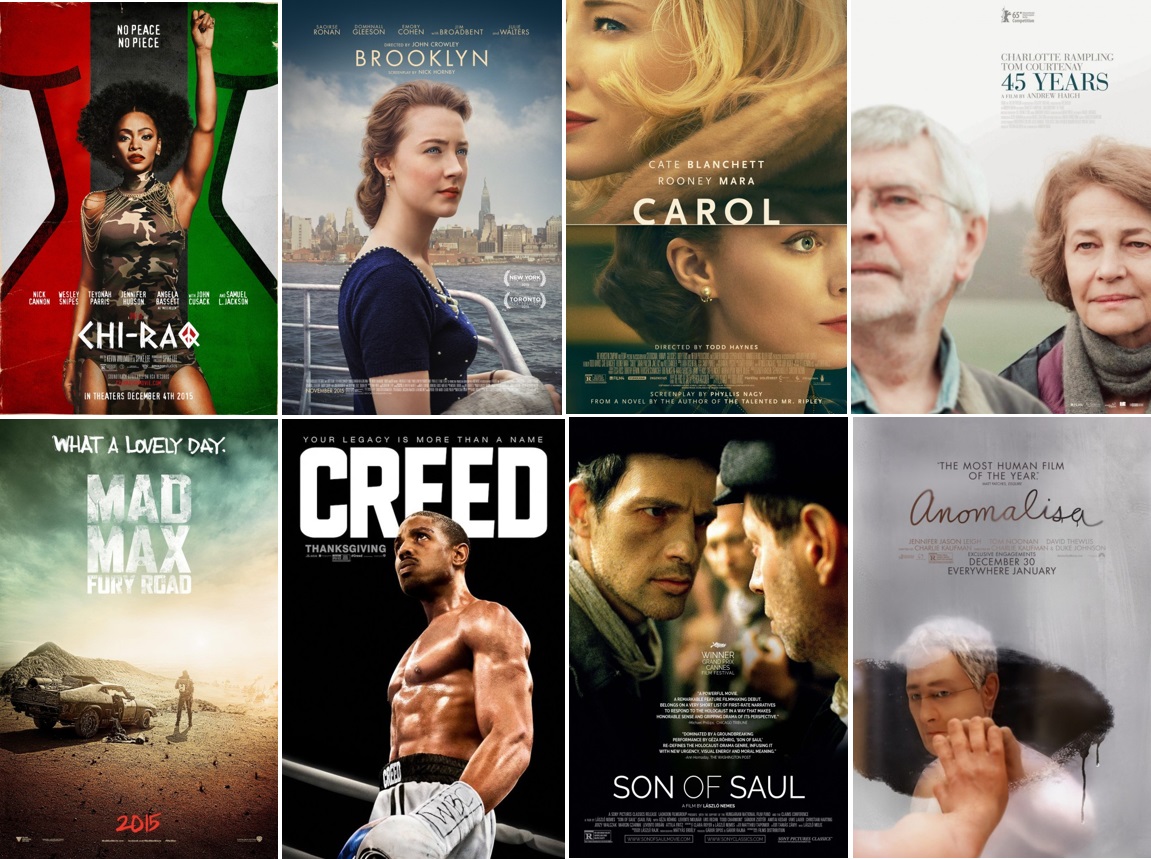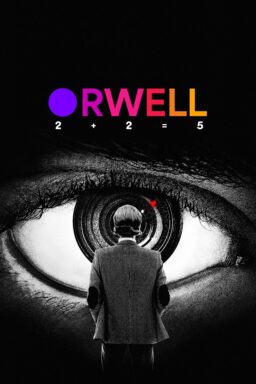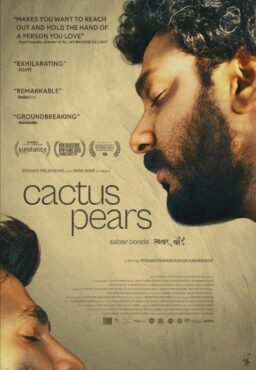A wife
realizing how much of her life has been based on chance. Two of the best
animated films of the modern era. A searing indictment of violence in modern
America. From Chicago to Brooklyn, from the future to the past, the year in
cinema reflected a remarkable breadth of subject matter, tone and style. What
do George Miller, Tom McCarthy and Ryan Coogler’s visions have in common other
than being those of devoted, passionate filmmakers? As only the best film has the
ability to do, this year’s ten movies transported us to places we had never been,
reflected in eyes that somehow felt like our own.
About the rankings: We asked our ten regular film critics and two
assistant editors to submit top ten lists from this great year, and then
consolidated them with a traditional points system—10 points for #1, 9 points
for #2, etc.—resulting in the list below, with a new entry for each awarded
film. We’ll publish all of our individual lists, along with many more by our
regular contributors and some with detailed entries, tomorrow.

“Chi-Raq” is proof that,
despite a 30-year career in the business, Spike Lee is still capable of
igniting controversy with one of his joints. The fire this time started with
the incendiary title—a moniker for Chicago—and spread with Lee’s use of the
ancient Greek satire, “Lysistrata,” as his source material. Aristophanes’ play
told of a sex strike by Greek women to force peace during the Peloponnesian
War. “Chi-Raq” transports the sex strike to the present day, where the murder
statistics in Chicago read like the casualties of an actual war. Lee was
immediately accused of turning innocent deaths into comic fodder. Though
“Chi-Raq” is full of broad, sexual comedy (sometimes to its detriment), not
once does it mock those who have fallen victim to untimely, unwarranted death
by gunfire.
Instead, “Chi-Raq” is a
scathing indictment of American gun culture, one that forces viewers to hold
two sometimes opposing thoughts of comedy and pathos in their heads
simultaneously. While the excellent Teyonah Parris goes through her satirical
military paces (and Samuel L. Jackson provides Dolemite-style commentary),
powerhouse dramatic actors like Angela Bassett and John Cusack preach on the
sad and horrible collateral damage wrought by bullets unconcerned with hitting
the wrong targets. Lee’s true intentions are encapsulated in a powerful scene
with Chicago native Jennifer Hudson. Her wordless scrubbing of her screen
daughter’s blood off the street makes a truly harrowing metaphor: When she
dumps her scrub bucket, it looks as if Hudson is pouring more blood on the
street than she is cleaning off it. Visuals like this show that Lee’s anger is
not at all diluted by humor. And while “Chi-Raq” often feels like a hot mess with
wild tonal shifts that amazingly don’t derail it, it is also far too alive,
original, funny and devastating to ignore. (Odie Henderson)

9. “Creed”
(Ryan Coogler)
There’s a sequence in “Creed,” where Michael
Jordan (playing Adonis Creed, son of the legendary Apollo)
runs through the streets of Philadelphia, followed by a swarm of guys on
motorcycles, accompanied by swelling surges of music. Adonis ends up below the
window of a gym shouting up at Rocky Balboa (Sylvester Stallone, of course).
You don’t hear what he’s shouting. You don’t need to. It’s a moment of
ferocious tribute, all while motorcyclists circle around Adonis, doing
wheelies. It’s a stunning scene—cheesy yet powerful, transparent and emotional, and it’s even more extraordinary that those elements sustain themselves
throughout. “Creed” shivers with adrenaline, not just physical,
but emotional.
Stallone’s
performance is not a revelation to those who have always found him to be a good
actor (there’s a fight with his son on the sidewalk in “Rocky
Balboa” that is among the best work Stallone has ever done), but he is
magnificent here. Stallone allows it to be Jordan’s movie, playing gentle,
humorous, touching support staff. Jordan gives a star performance, carrying the
whole thing on his shoulders. Stallone
has said that he wanted the franchise to remain “intact,” and
director Ryan Coogler has done that. “Creed” is a tribute (as the
motorcycle sequence makes explicit), but instead of being a retread, something
thrillingly contemporary has been injected into the familiar skeleton of
the story.
When a
press screening filled with film critics erupts into applause at the familiar
sound of the “Rocky” theme, you know a film has tapped into something
enormous. “Creed” is unafraid of being entertaining, unafraid of the
big gestures (those big gestures have such archetypal meaning to so many), not
cynical about the past but still pushing towards a bright future.
“Creed” is pure show biz, in the best sense of the word. (Sheila O’Malley)

8. “Son of Saul” (László Nemes)
László
Nemes’ “Son of Saul” is a full-force immersion into a Hell on Earth.
Horrifically, the setting is true, taking place during the last days of the
Holocaust. But, in an even bleaker sense, the movie has an apocalyptic feeling;
sans historical details, it is a timeless presentation of what happens when
humanity feels to be a lifetime away, and death has become an industry run by
hate. The film is about a single seed of empathy amongst genocide. It follows a
Jewish prisoner (Géza Röhrig, his eyes and headstrong gaze a year-best
discovery) who is forced by his captors to help execute his people. At the
beginning of the movie, he assigns himself to properly bury a young boy whose
body he salvaged from other corpses. Under the noses of his captors and with
little help from his peers waiting for their time of execution, the self-willed Saul risks everything to find a rabbi who will help him, seeking to restore
this small fragment of order to a world that has completely fallen apart.
Aside from
Nemes’ direction, which is as daring as any hungry, green director’s but with
an extraordinarily focused vision, this unrelenting experience is defined in
great part by Mátyás Erdély’s cinematography. As in his work “James White,”
Erdély places viewers right in the expressive faces of his protagonists from
the first image, while a horror that is too devastating to fully comprehend
fills their background. His work on “Son of Saul” features many impressive,
breathless shots, where the framing is immediate and claustrophobic.
Along with a
devastating sound design and production design that orchestrates such palpable
horror, “Son of Saul” is cinema at its most devastating, but also most
compassionate. Up to its last frame, Nemes’ fantastic debut is a wayward
journey guided by cryptic optimism, a story of intense horror that is also
about the endurance of hope. (Nick Allen)

7. “Carol” (Todd Haynes)
Richly
creamy and achingly romantic, “Carol” is yet another impeccable piece of
filmmaking from the great Todd Haynes and an excellent companion piece to
Haynes’ “Far From Heaven,” my pick for the best film of 2002. Both tell the
story of women pursuing forbidden love in the 1950s and evoke that period in
American history with vivid detail, both aesthetically and thematically.
Everything about this movie is pristine in terms of its production values—the
costumes, the art design, the lush cinematography from Edward Lachman and the
melancholy score from Carter Burwell. But the love affair between Cate
Blanchett and Rooney Mara gives “Carol” its sweetly beating heart. They share a
lovely and substantial chemistry that leaves you with both a lingering wistful
feeling and a tantalizing bit of uplift. Although the film is thoroughly
convincing as it transports us to a time decades ago, the purity of the romance
between Blanchett and Mara’s characters and the strength of their connection
makes the film feel immediate, contemporary and relatable. Blanchett, ever the
technical master, disappears into the glamorous longing of the wealthy but
miserable housewife Carol. And Mara, by contrast, is all youthful instinct as
Therese, the ingénue who blossoms as she realizes her true identity and desire.
Sparks fly from the second they meet, despite the rather mundane setting of a
department store during the Christmastime crunch. But Phyllis Nagy’s script,
based on the Patricia Highsmith novel “The Price of Salt,” beautifully
establishes the deep friendship that develops between the two women over a long
time. And so when they finally do surrender to their yearnings, it feels not
only earned but true. “Carol” is both an affirmation and a promise. (Christy Lemire)

6. “45 Years” (Andrew Haigh)
We like to
think that we are in complete control of our destinies. We like to think we
have carved the paths that have led us to the current phase of our existences.
To a certain extent, of course, we have, but there are so many things that
impact our lives that are not just out of our control but about which we may
never know. Andrew Haigh’s devastating “45 Years” is about a woman who learns
about one of those monumental turns of fate in her life decades after it
happened. Kate (Charlotte Rampling) and Geoff Mercer (Tom Courtenay) are
planning a party for their 45th anniversary. As often happens when
major events are in motion, life throws them a curveball. Geoff gets a letter that the body of his ex-girlfriend, Katya, who went missing 50 years ago, has
been discovered. It sends both Geoff and Kate into a melancholic tailspin. He
seems distant, thinking about a life that might have been. She begins to wonder
how much of her partnership was determined by the disappearance of another.
There are
many notable elements of “45 Years,” including director Andrew Haigh’s subtle
use of space and music, but it’s Charlotte Rampling’s performance that drives
it home. What’s so remarkable about her work—my favorite performance of the
year in any category—is its internal register. As Kate digs deeper into what
Katya meant to Geoff, she realizes how much this woman that she never met and
barely knew a thing about pushed her to where she is today. And Rampling turns
inward. Look at her eyes in the mirror, try to read her thoughts in the devastating
final scenes, realize that there’s nothing that this woman can say to change
what happened 50 or 45 years ago. None of us can. (Brian Tallerico)

5. “Brooklyn” (John Crowley)
“Brooklyn” is
that rare romantic-drama with power and honesty that comes from recognizing its characters’
limitations. Irish immigrant Eilis (Saoirse Ronan) is not a progressive righter
of dated wrongs, or a tragic emblem of the times—she is a young woman in love.
Her modest and determined character stem from her refusal to take any slight or challenge as a personal affront. There are several characters who,
at one time or another, get in the way of her happiness, like imperious
department store manager Miss Fortini (Jessica Paré), and the gossipy girls that Eilis
rooms with while she makes her way in New York. But Eilis doesn’t have an
adversarial relationship with these women (and it is often women, thankfully).
Instead she befriends them, knowing that an independent new
life can only be made with the understanding that the universe is not out to
get you.
So when Eilis
becomes enamored with fellow immigrant Tony (Emory Cohen) and fellow Irishman
Jim Farrell (Domhnall Gleeson), she never experiences a great, anguished
internal conflict. “Brooklyn’s” emotions are far more believable, and even
deceptively potent because they’re so small. The film’s lovers stumble over
their words, and are constantly amazed at the depth of feeling that they convey
to each other through simple gestures like a home-cooked meal, a post-dance
chat, writing and receiving letters, or just holding hands. Director John
Crowley and screenwriter Nick Hornby’s adaptation of Colm Tóibín’s novel
encourages viewers to take comfort in knowing that one can be both pragmatic
and sincere. Eilis and her loved ones sometimes disappoint each other, and are
never capable of being everything to each other all the time. But there’s
a real, true faith in humanity at the heart of “Brooklyn” that makes it one of
the most gratifying films of the year. (Simon Abrams)

4. “Spotlight” (Tom McCarthy)
You can describe “Spotlight” as a
gripping procedural about how The Boston
Globe uncovered the depths of deception that the Catholic Church stooped to
while obscuring the widespread sexual abuse of children by priests. But
director Tom McCarthy and his co-writer Josh Singer strive for much more than
simply presenting an unabashed celebration of the type of Pulitzer-winning
journalism that is on the verge of extinction at a time when even major
newspapers struggle for survival.
“Spotlight” also draws its dramatic
power from exposing the very souls of those touched by the scandal. From the
astonishingly dedicated team of investigative reporters who put their jobs
first and private feelings second, to the emotionally scarred victims who poured
their hearts out in interviews while revisiting a painful past. From the smug
clergymen at every level, who thought nothing of lying to not only the press but
to their parishioners about the extent of the crisis, and the lawyers who
benefitted from the conspiracy while showing little concern for the poor and
needy who were the main targets. The film also lays bare the blinkered
insularity of this most American of U.S. cities that has, rightly or wrongly,
regularly been portrayed on TV and film as being beset by crime and prejudice.
As the best journalism does, McCarthy
goes out of his way to provide a positive side to the story. These editors and
reporters, along with those who voluntarily helped them find the truth, define
the term “Boston Proud.” They did a massive amount of research and legwork
because they care about their community. The greatest tribute that the
filmmakers could pay was to have hired one of the highest-caliber ensemble
casts of recent vintage, including Liev Schreiber as tack-sharp editor
Marty Baron and Len Cariou as a slippery Cardinal Law, to portray them.
Even more importantly, the filmmakers
have not only made a movie about events that took place some 14 years ago seem
utterly relevant. They depict the glories inherent in any job well done—and for
all the right reasons. (Susan Wloszczyna)

3. “Anomalisa” (Charlie Kaufman & Duke
Johnson)
Just when
you think there’s nothing new to be said about human alienation, the writer and
director Charlie Kaufman presents a scenario to make you see loneliness in an
entirely unusual way. Working here with the animation director Duke Johnson,
Kaufman uses meticulously designed and animated stop-motion models (shades of
the puppets of the Kaufman-penned “Being John Malkovich”) to, um, flesh out a
concept about which the less is known before you view, the better. In a sense,
this is the story of an ordinary man behaving irresponsibly on an ordinary
business trip (the action is mostly confined to a meticulously miniaturized
blah hotel in Cincinnati, Ohio; its sterile rooms, its faux-tasteful bar, its
comatose lobby); once the central conceit reveals itself, “Anomalisa” becomes a
tender, funny, unnerving, and eventually heartbreaking and terrifying journey
into a spiral of near-metaphysical dysfunction. The movie’s realization,
eschewing digital technology and keeping the animation in the painstakingly
hand-cranked realm, took over two years. The performances of the voice cast,
featuring David Thewlis, Jennifer Jason Leigh and Tom Noonan, are impeccable.
The perfection of the result is a form/content match of uncanny aptness, and
yields a spectacularly haunting film. (Glenn Kenny)

2. “Inside Out” (Pete Docter)
In the wake
of a few surprisingly uninspired efforts, Pixar Animation Studios returned
to top form with one of their finest films to date, a hilarious, heartwarming
and genuinely thoughtful tale that takes us into the mind of an ordinary girl
and introduces us to her key emotions—Joy (Amy Poehler), Sadness (Phyllis
Smith), Anger (Lewis Black), Disgust (Mindy Kaling) and Fear (Bill Hader)—as
they try to help her navigate the perils of a new home, school and friends.
Like the best Pixar films, it takes an absolutely inspired idea and presents it
in a spectacularly entertaining and innovative manner that mines the material
for a lot of laughs (including some advanced ones that will have the adults
chuckling), plenty of earned sentiment (I suspect the final sacrifice of
long-lost imaginary friend Bing Bong will be to this generation of children
what the passing of Bambi’s mother was to their parents and grandparents) and
enough real insight into the nature of human emotion that it could serve as a
teaching tool to help explain the tricky subject to kids. Long after the tie-in
T-shirts have faded and the stuffed toys have been relegated to a closet, my
guess is that kids who see it will continue to carry around the lessons they
learned from it, and when they have kids themselves, they will use it to pass
those lessons on to their offspring. (Peter Sobczynski)

1.
“Mad
Max: Fury Road” (George Miller)
George
Miller, the director of “Mad Max: Fury Road,” as
well as the director or co-director of every other entry in the series, was 70
when his latest work hit theaters. You could tell, and yet you couldn’t. It is
one of the best new-school action films of recent years, but at the same time,
paradoxically, the most old-fashioned. The fourth installment in this
post-apocalyptic saga has plenty of characteristics that smack of a “2015
reboot,” or at least a revamp. It scrambles after dude-pleasing
“awesomeness” quite unabashedly, and makes the most of its wild juxtapositions
and gleefully ridiculous images, such as combatants atop long poles swaying above
the caravans like conductor’s batons, and drummers and a fire-spitting guitar
player providing a mobile soundtrack to the film’s seemingly neverending chase.
It fills its lead role with the puppy-loving method hunk Tom Hardy rather than
bringing back its original lead actor, the increasingly unhinged and
unemployable caveman Mel Gibson. With help from playwright Eve Ensler (“The Vagina Monologues”), Miller and his screenwriters rethought the series’
ethos to make its women more complex as well as more central to the plot;
there are points in the film where Charlize Theron’s transport driver,
Imperator Furiosa, the would-be rescuer of a water-hoarding dictator’s harem,
seems to be driving the story in every sense, with Max serving as her reluctant
ally and enabler rather than as her protector or mentor or teacher, or whatever
other role that a male title character would usually play in this sort of
movie.
The style of “Mad
Max: Fury Road” draws heavily on next-gen video games and music videos, with
brighter colors, more crowded frames and much faster cutting than audiences saw
the last time out (1985’s “Mad Mad Beyond Thunderdome”). At the same time, “Mad Max: Fury Road” is very old-fashioned, modeling some of its longer, wider
shots on John Ford and Akira Kurosawa (great use of shadows and silhouettes),
and drawing its symbolism and foreshadowing from parables, myths and religious
texts, as well as Homer’s “The Iliad” and “The Odyssey,” epic poems
that have informed the entire series. (A maybe-or-maybe-not related trivia
note: Miller’s family is Greek, and changed its name from Miliotis.) This is a
movie so determined to connect to viewers through images alone that you could
easily imagine it as a black-and-white silent picture from about 1928—and
wouldn’t you know it, there are plans to re-release the movie in monochrome to
theaters. Maybe they’ll go all the way, drop the sound out and add title cards. (Matt Zoller
Seitz)











